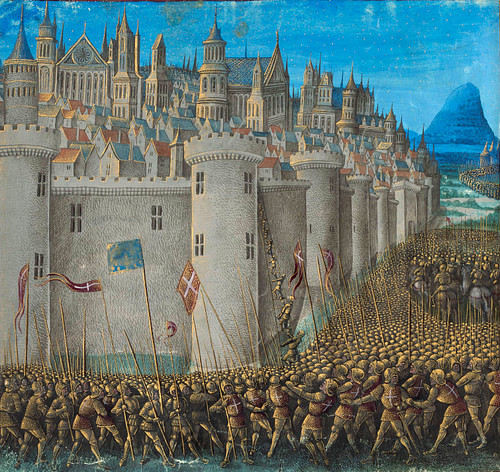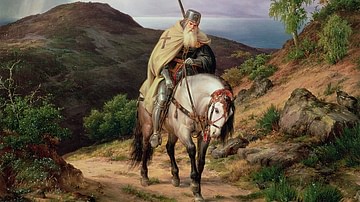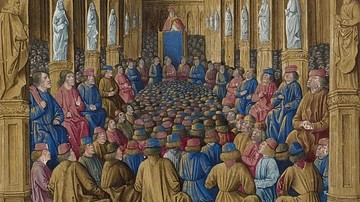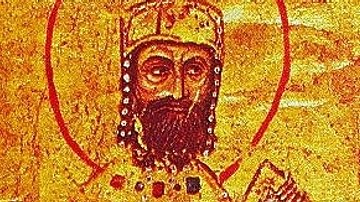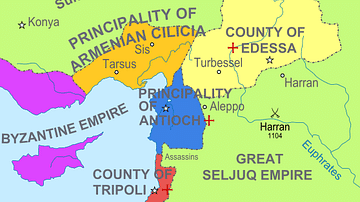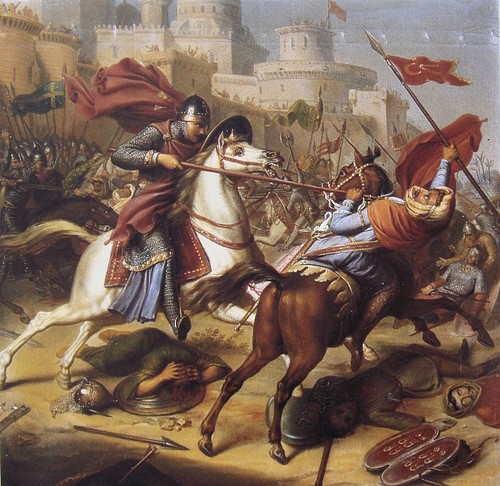
The First Crusade (1095-1102) was a military campaign by western European forces to recapture the city of Jerusalem and the Holy Land from Muslim control. Conceived by Pope Urban II following an appeal from the Byzantine emperor Alexios I Komnenos, the Crusade was a success with Christian forces taking control of Jerusalem on 15 July 1099.
Around 60,000 soldiers and at least half again of non-combatants were involved in the First Crusade which set off on their quest in 1095. After campaigns in Asia Minor and the Middle East, great cities such as Nicaea and Antioch were recaptured, and then the real objective, Jerusalem itself. Many more crusades would follow, the objectives would widen, as would the field of conflict, so that even Constantinople would come under attack in subsequent campaigns.
Causes of the First Crusade
The first and most important action to spark off the fuse which would eventually burn down to the explosion of the First Crusade was the rise of the Muslim Seljuks, a Turkish tribe of the steppe. The Seljuks won significant victories in Asia Minor against Byzantine armies, notably at the Battle of Manzikert in ancient Armenia in August 1071. As a consequence, they gained control of such great cities as Edessa and Antioch and, c. 1078, the Seljuks created the Sultanate of Rum with their capital at Nicaea in Bithynia in northwest Asia Minor. By 1087 they had taken control of Jerusalem.
The Byzantine emperor Alexios I Komnenos (r. 1081-1118) realised the Seljuk expansion into the Holy Land was a chance to gain the help of western armies in his battle to control Asia Minor. Consequently, Alexios appealed to the west for soldiers in March 1095. The appeal was sent to the Pope Urban II (r. 1088-1099) who proved remarkably responsive, as did thousands of European knights.
Pope Urban II had already sent troops to help the Byzantines in 1091 against the Pecheneg steppe nomads who were invading the northern Danube area of the empire. He was again disposed to assistance for various reasons. A crusade to bring the Holy Land back under Christian control was an end in itself - what better way to protect such important sites as the tomb of Jesus Christ, the Holy Sepulchre in Jerusalem. Christians living there or visiting on pilgrimage also required protection. In addition, there were very useful additional benefits.
A crusade would increase the prestige of the papacy, as it led a combined western army, and consolidate its position in Italy itself, having experienced serious threats from the Holy Roman Emperors in the previous century which had even forced the popes to relocate away from Rome. Urban II also hoped to make himself head of a united Western (Catholic) and Eastern (Orthodox) Christian church, above the Patriarch of Constantinople. The two churches had been split since 1054 over disagreements about doctrine and liturgical practices. In case anyone was concerned, a campaign of violence could be justified by references to particular passages of the Bible and emphasising this was a fight for liberation, not attack, and that the objectives were just and righteous ones.
On 27 November 1095, Urban II called for a crusade in a speech during the Council of Clermont, France. The message, known as the Indulgence and aimed specifically at knights, was loud and clear: those who defended Christendom would be embarking on a pilgrimage, all their sins would be washed away, and their souls would reap untold rewards in the next life. Urban II then embarked on a preaching tour in France during 1095-6 to recruit crusaders, where his message was spiced up with exaggerated tales of how, at that very moment, Christian monuments were being defiled and Christian believers persecuted and tortured with impunity. Embassies and letters were dispatched to all parts of Christendom. Major churches such as those at Limoges, Angers, and Tours acted as recruitment centres, as did many rural churches and especially the monasteries. The call to “take the cross” - where people swore an oath to become a crusader and then wore a cross on their shoulder to proclaim their obligation - was an amazing success. Across Europe warriors, stirred by notions of religious fervour, personal salvation, pilgrimage, adventure and a desire for material wealth, gathered throughout 1096, ready to embark for Jerusalem. The departure date was set for 15 August of that year. Around 60,000 crusaders including some 6,000 knights would be involved in the first waves.
The Muslim Enemy
The Seljuk Muslims who had taken control of most of Asia Minor and northern Syria in the latter decades of the 11th century were suffering their own particular problems even before the crusaders arrived. In conflict with their bitter rivals, the Shiite Fatimids, based in Egypt, the Sunni Seljuk Muslims had wrestled Jerusalem from them. However, a serious blow to Seljuk ambitions came with the death of the powerful Seljuk Sultan Malikshah in 1092 which produced a scramble for power by various local lords with none gaining supremacy. Further, the Seljuk base was in Baghdad, a long way from the battles which would occur throughout the First Crusade, and so there was little centralised support or management of the war. Added to this, the Shiite Muslims managed to recapture control of Jerusalem from the Seljuks just a few months before the Crusaders arrived on the scene. Both groups of Muslims were most likely completely unaware of the religious nature of the Crusader's quest and that they were any different from usual Byzantine raiding parties. The noble knights from the west, though, were not interested in harassing an enemy and carrying off portable riches, they were in the Levant for permanent conquest.
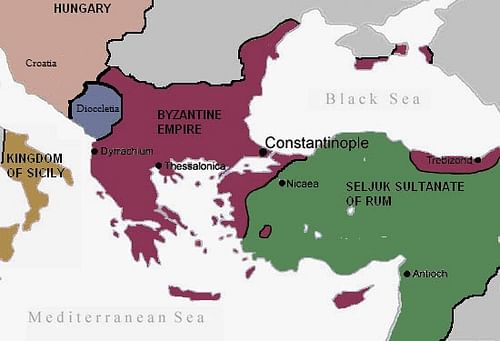
Peter the Hermit & the 'People's Crusade'
Ironically, and despite the Pope's deliberate intentions to appeal specifically to knights (which is what Alexios had asked for), a whole lot of other people were bitten by the crusading bug. The first major group was the people's army, a mixed group of poor and petty knights. They were led by the preacher Peter the Hermit and the knight Walter the Penniless (Sansavoir). Ill-equipped and by necessity driven to foraging as they crossed Europe, they made few friends along the way. Peter had earlier been on a pilgrimage to the Holy Land where he had been captured by Muslims and tortured, now was his chance for revenge.
Meanwhile, a second group of crusaders, equally humble and ill-disciplined, made its way down the Rhine. Led by Count Emicho of Leningen, the group infamously turned their religious hatred to Jews in Speyer, Mainz, Trier, and Cologne. Both groups of crusaders, sometimes referred to as the 'People's Crusade' (despite actually containing some knights), arrived in Constantinople in the early summer of 1096 with the aim of then moving on to Jerusalem to remove the Seljuks. These first-comers are described by Anna Komnena (1083-1153), historian and daughter of the Byzantine emperor, in her Alexiad:
And those Frankish soldiers were accompanied by an unarmed host more numerous than the sand or the stars, carrying palms and crosses on their shoulders; women and children, too, come away from their countries. (Gregory, 296)
They were promptly shipped by Alexios to Asia Minor, where, ignoring the Byzantine's advice, they were ambushed and wiped out near Nicaea by a Seljuk army led by Kilij Arslan I on 21 October 1096. This was not what Alexios or Pope Urban II had had in mind when they started off the crusade movement.
The Fall of Antioch
The second wave of crusaders, this time composed of more gentlemanly and knights and professional warriors, arrived in Constantinople in the autumn and winter of 1096. The second batch was not much of an improvement as far as the Byzantine emperor was concerned as it included amongst its leaders an old enemy, the Norman Bohemund of Taranto. He and his father, Robert Guiscard (the “Crafty”), the Duke of Apulia, had attacked Byzantine Greece between 1081 and 1084. In 1097 Bohemund and his knights arrived in Constantinople and initially, things went well with the Norman swearing allegiance to the emperor along with other Crusader leaders such as Godfrey of Bouillon, the Duke of Lower Lorraine, and Raymond IV (aka Raymond de Saint-Gilles), Count of Toulouse. There were many more nobles besides, and with each commanding their own contingent of knights, not to mention the practical problems of language barriers, it was a minor miracle the force achieved anything at all. Their success would surprise everyone.
Alexios used the crusaders well, despite the rape and pillage perpetrated by the less pious members of the western armies which were causing chaos as they crossed Europe and the Empire's territory. The Normans were keen to defeat the Seljuks and establish some new kingdoms of their own. Alexios may well have gone along with this plan as such kingdoms might prove a useful buffer on the Empire's border. With a mixed force of crusaders, Alexios' army, commanded by the Byzantine general Tatikios, thus managed to recapture Nicaea in June 1097, although the Seljuks had, in reality, preferred to abandon it and fight another day. Next, they swept on over the Anatolian plain and won a great victory at Dorylaion on 1 July 1097.
The crusader-Byzantine army then split up in September 1097, with one army moving on to Edessa further to the east and another into Cilicia to the south-east. The main body headed for Antioch in Syria, the key to the Euphrates frontier. The great city was one of the five patriarchal seats of the Christian church, once home to Saint Paul and Peter, and probable birthplace of Saint Luke. It would be a fine propaganda coup to get it back again.
Although well-fortified and too big to fully encircle, Antioch was indeed the next big crusader capture on 3 June 1098 after an arduous 8-month siege where the attackers themselves came under siege from a Muslim force from Mosul. The Crusaders also suffered from plague, famine, and desertions. Unfortunately for Alexios, on his way to support the siege of the city he had met refugees from the area who wrongly informed him that the Crusaders were on the brink of defeat to a huge Muslim army and so the emperor returned home. Bohemund was not best pleased to find out his army had been abandoned by the Byzantines, even if he did capture the city anyway and defeat a relief force. The Norman decided to renege on his vow to return all captured territory to the Emperor and kept the city for himself. The relations were thus irrevocably soured between the two leaders.
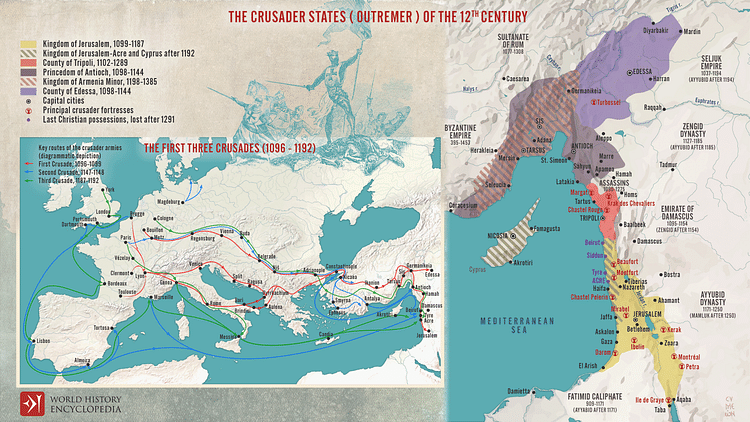
The Capture of Jerusalem
In December 1098 the crusader army marched onwards to Jerusalem, capturing several Syrian port cities on their way. They arrived, finally, at their ultimate destination on 7 June 1099. Of the vast army that had left Europe there were now only around 1,300 knights and some 12,500 infantry to achieve what was supposed to be the primary goal of the Crusade.
Protected by massive walls and a combination of moat and precipices, Jerusalem was going to be a tough military nut to crack. Fortunately, a number of Genoese ships arrived at just the right moment with timber, which was used to make two siege towers, catapults, and a battering ram. Despite these weapons, the defenders resisted the siege, although the Muslim garrison was remarkably reluctant to break out and make raids on the besiegers, perhaps being content to sit and await the promised relief from Egypt. Then, in mid-July, Godfrey of Bouillon decided to attack what he thought looked like a weaker section of the wall. Setting up their siege tower under the cover of darkness and filling a portion of the moat, the Crusaders managed to get in touching distance of the walls. With Godfrey leading from the front, the attackers scaled the defences and found themselves inside the city on 15 July 1099.
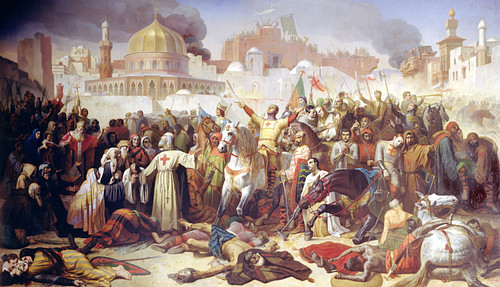
A mass slaughter of Muslims and Jews followed, although figures of 10,000 or even 75,000 killed are very likely an exaggeration. A contemporary Muslim source (Ibn al-Arabi) puts the figure at 3,000 of the city's probable 30,000 residents. Within a month, a large Egyptian army arrived to take back the city, but they were defeated at Ascalon. Jerusalem, for the time being at least, was back in Christian hands; Godfrey of Bouillon, the hero of the siege, was made the king of Jerusalem. Back in Italy, Pope Urban II had died on 29 July 1099 without knowing the success of his crusade. For some historians, Ascalon marks the end of the First Crusade.
More Victories
Having accomplished their mission, many crusaders now returned to Europe, some with riches, a few with holy relics, but most rather worse for wear after years of hard battles and scant reward. A fresh wave of crusaders, though, arrived in Constantinople in 1100, and they were organised by Raymond of Toulouse. On 17 May 1101 Caesarea was captured; on 26 May Acre fell too. Ominously, though, for future crusades, the Muslims were becoming more familiar with western battle tactics and weapons. In September 1101 a crusader army of Lombard, French, and German knights was defeated by the Seljuks. Things were only going to get more difficult for western armies over the next two centuries of warfare.
Meanwhile, Alexios had not given up on Antioch, and he sent a force to attack the city or at the very least isolate it from the surrounding Crusader-held territories. Bohemund had left, though, and returning to Italy, he convinced Pope Paschall II (r. 1060-1118) and the French king Philip I (r. 1060-1108) that the real threat to the Christian world was the Byzantines. Their treacherous emperor and wayward church had to be eliminated, and so an invasion of Byzantium, the precise location being Albania, was launched in 1107. It failed, largely because Alexios mobilised his best forces to meet them, and the Pope abandoned his support of the campaign. As a result, Bohemund was forced to accept subservience to the Byzantine emperor, who let him rule Antioch in Alexios' name. Thus, the pattern was set for a carving up of captured territories.
Assessment: Achievements & Failures
The First Crusade was successful in that Jerusalem was recaptured, but to ensure the Holy City stayed in Christian hands, it was necessary that various western settlements were established in the Levant (collectively known as the Crusader States, the Latin East or Outremer). Orders of knights were created, too, for their better defence. Clearly, a steady supply of new crusaders would be needed in the coming decades and a wave of taxes to fund them. Initially, there were massacres of local populations, but the westerners soon realised that to hold on to their gains they needed the support of the extraordinarily diverse local populations. Consequently, there grew a toleration of non-Christian religions, albeit with some restrictions.
Despite the continued recruitment drive in Europe and attempts to create permanent 'colonies' and kingdoms, it proved impossible to hold on to the gains of the First Crusade, and more campaigns were required to recapture such cities as Edessa and Jerusalem itself after its fall again in 1187. There would be eight official crusades and several other unofficial ones throughout the 12th and 13th centuries, which all met with more failure than success.
There were unforeseen or negative consequences to the First Crusade, notably the rupture in western-Byzantine relations and the Byzantines horror at unruly groups of warriors causing havoc in their territory. Outbreaks of fighting between crusaders and Byzantine forces were common, and the mistrust and suspicion of their intentions grew. It was a troublesome relationship that only got worse, and the ill-feeling and mutual distrust between east and west would rumble on and culminate in the sacking of Constantinople in 1204.
Crusader groups, usually not knights but the urban poor, took the opportunity of Christian fervour to attack minority groups, especially Jews in northern France and the Rhineland. The crusading movement also spread to Spain where, in the second and third decades of the 12th century, attacks were made against the Moors there. Prussia, the Baltic, North Africa, and Poland, amongst many other places, would also witness crusading armies up to the 16th century as the crusading ideal, despite the dubious military successes, continued to appeal to leaders, soldiers, and ordinary people in the west, and its target widened to include not only Muslims but also pagans, schismatics, and heretics.
